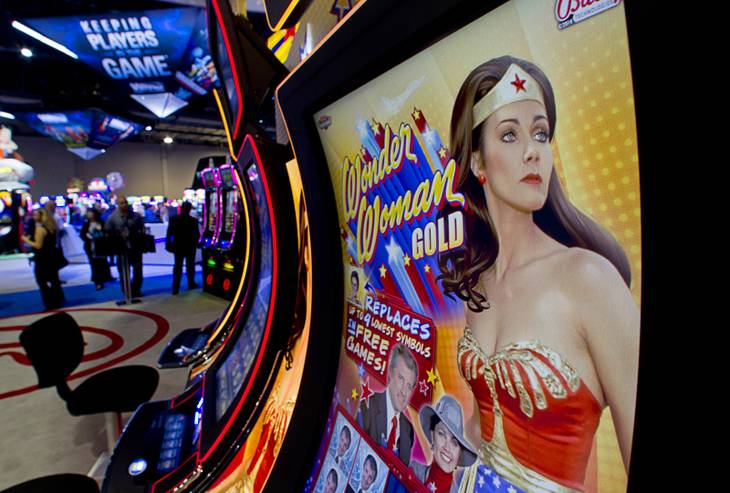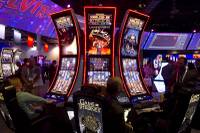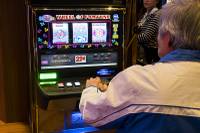Gov. Brian Sandoval was chairman of the Nevada Gaming Commission in January 2000 when the panel enacted a ban on slot machines with cartoon themes deemed appealing to minors.
“This is a remarkable and landmark day,” Sandoval said upon approval of Regulation 14.025 (dubbed “Slots for Tots”). “This will be a model that will be followed by the rest of the country, if not the world,” Sandoval said.
Controversy over a slot machine built on the TV-MA-rated cartoon “South Park” had sparked then-presidential contender Sen. John McCain, R-Ariz., to call on the Federal Trade Commission to investigate whether casino marketing practices were picking up where cigarette mascot Joe Camel left off, luring minors into a potentially addictive abyss.
Sandoval and the Nevada Gaming Commission jumped into action to preempt federal activity and reaffirm that Nevada knew best how to regulate the gaming industry, even as casinos proliferated nationwide.
But stroll through just about any Strip property today and you might hear Fred Flintstone bellowing “Yabba-dabba-doo!” Homer Simpson yelping “Do’h!” or Stewie Griffin declaring “Victory is mine!”
Slot machines based on popular cartoons, sitcoms, reality shows and other Hollywood creations are increasingly common on casino floors. Games include “The Big Bang Theory,” “Game of Thrones,” “Orange Is the New Black,” “Ellen,” “Judge Judy,” “Pawn Stars,” “American Idol,” “The Voice,” “Titanic,” “Wacky Racers,” “Gremlins” and myriad other titles, old and new, from just about all genres.
“You try to make games to appeal to the widest audience,” said Phil Gelber, senior vice president of product development for Scientific Games. “A good game is a good game, but people walk in with different expectations of what a game will deliver, so you have to design for all of them.”
Branded games that draw from recognizable characters to inspire players have changed the look of casino floors. And in doing so, they’ve grown a model of third-party partnerships, with slots now considered an acceptable added revenue stream in the entertainment ecosystem, similar to toys, videos, books and other product spin-offs of licensable brands,
POP CULTURE CURIOSITY
Branded games represent 10-15 percent of Scientific Games’ slot portfolio, Gelber said. Overall, just less than 25 percent of all slot themes are based on licensed or branded content and are occupying an increasing amount of casino floor space in the past five years, according to Jim Barbee, chief of the Gaming Control Board’s Technology Division.
“Most slot players look for what’s new on the casino floor,” Gelber said. “Players are curious. If they like a certain show, they want to see how it’s adapted to slot play. A familiar face makes the games more approachable and more likely to be given a try.”
Daren Perlstein, 53, and his wife, Sharon, were at Planet Hollywood on a recent Tuesday night playing “Game of Thrones,” a penny slot with wagers between $1.50 and $4.50 on each spin.
“We’re huge fans. It’s our favorite show,” said Perlstein, a Los Angeles-area resident who was in town to shop for a house. They came to Planet Hollywood specifically to play this machine, they said, after noticing the game while walking through the Miracle Mile Shops the night before.
“We’ve played it every day,” his wife added. “And we’ll play it tomorrow.”
Perlstein said he had played similar machines before, “but once they got ‘Game of Thrones,’ I’ve been sticking to this one.”
The size of branded game cabinets is often part of their appeal. With curved screens rising toward ceilings, surround-sound audio environments, and some with cushy vibrating chairs, these games attract the attention of players, and potential players standing nearby.
“You see a lot of those games with larger-than-life-style executions to pull people in,” Gelber said. “You usually see the brands on the games with bigger screens and bigger hardware. Those were risky investments for us. Putting the brand on it lowers the barrier of entry. We know when a brand is already popular, more people will try the game.”
While the brand may be the initial draw, from there he said the game itself has to be good to keep players playing.
“Slots stay on floors because they perform. The game’s got to be good to keep them there,” Gelber said. “Players vote with their wallets very easily in this day and age if the game doesn’t meet their expectations.”
Nostalgia drew Michelle Brass from Carolina Beach, N.C., to a bank of “Wonder Woman” machines at the Cosmopolitan.
“I love ‘Wonder Woman.’ I’m a child of the ’70s, so I had to play it,” Brass said just before hitting a bonus and joining the machine in song. “Wonder Woman,” she sang, hands in the air, as her credits tallied up.
“I’m not a huge gambler by any means,” Brass said. “We’re here on vacation before Christmas, just having a good time. It’s fun when you win because you get to hear it go ‘Wonder Woman.’ ”
She said the game had kept her attention for nearly three hours of button pressing. “I’m in for $90 after, and right now am at $95. So that’s pretty good, I am up five bucks,” a financial assessment she punctuated with yet another rendition of the namesake theme song.
“If you have a good game paired with a good brand,” Gelber said, “that’s something that will probably stay around for a while.”
REWRITTEN RULES
The idea of combining popular entertainment with slots began 20 years ago with “Wheel of Fortune.” The game-show-cum-slot-machine continues to rank, in terms of revenue generation, as the most successful slot machine of all time.
“Wheel of Fortune” proved the power of a good slot game paired with a known entity that appeals primarily to adults.
But it’s the appeal of nostalgia that allows a slot based on “Charlie and the Chocolate Factory” on casino floors.
With the initial Slots for Tots rule instituted in 2000, the Nevada Gaming Commission banned themes “based on a product that is currently and primarily intended or marketed for use by persons under 21,” but made clear exceptions for cases where “the theme is attractive to adults because of its nostalgic appeal.”
Although the language of the regulation didn’t change until 2015, interpretations of what the words meant did. Over the years, manufacturers learned what regulators had issues with, Gelber said, and the regulators did their job to make sure they could compete with other entertainment offerings.
“If our games were nostalgic, they tend to give us more leeway than they did 10 years ago,” Gelber said. “And we’ve had almost no problems in the last four or five years.”
In September 2015, the Gaming Control Board revised, and the Nevada Gaming Commission approved, a slimmed-down version of Regulation 14.025 as part of a broader regulatory overhaul that sought to bring gambling regulation up to date with today’s interconnected world.
“This was an attempt to streamline the process of getting games approved,” said A.G. Burnett, chairman of the Gaming Control Board. “We eliminated procedural hoops for addressing concerns while making it easier for equipment manufacturers to solve disagreements and address appeals. But the same core principles apply,” he said, noting that a product “currently and primarily” targeting youth of pre-gambling age would be off-limits.
But really, he added, the Gaming Control Board has seen few problems with Nevada licensees creating games that bring underage players into casino environments.
“We’ve never had a machine on the floor that we’ve had to pull because it was attracting kids like a moth to a flame,” Burnett said. “It just isn’t happening.”
Underage gambling as a result of youth-friendly themes simply is not a problem, he said. If it were, the board has mechanisms in place to shut it down immediately.
NEW AGE CONCERNS
Keith Whyte, executive director of the National Council on Problem Gambling, agreed that initial concerns over cartoonified slot play may have been overblown.
“Kids will be attracted to gambling no matter what,” Whyte said. “So the themes don’t really make a difference.”
However, Whyte said he is concerned about “simulated” casino-gambling efforts — many of which are supported by similar third-party branded relationships that “push” youth-friendly content to mobile phones with no regulatory oversight and little regard for implications for problem gamblers.
“The Wizard of Oz,” for example, is offered by Scientific Games for real-money play but is similarly offered by Zynga for play-money. These two different engagements of one popular brand illustrate potential pitfalls.
“Wizard of Oz” slots on Zynga is the free-play gaming company’s most successful slot game and the 31st biggest moneymaker of all games. It generates about $50,000 a day, according to mobile-gaming industry monitor ThinkGaming.
Players can’t win money, but they can earn credits for additional playing time or features. Because such play is technically not gambling, “Wizard of Oz” can be marketed to players as young as 13 while operating outside the purview of regulators.
“In the absence of regulation, they can do whatever the hell they want,” said Whyte, describing ads from companies outside the casino-gaming industry that celebrate addiction, encourage irresponsible play, and provide game experiences that can be harmful for players who transition to real-money gambling without understanding they are not the same.
Yet companies offering these games can convey a message through repetition, for example, that doubling your bet when losing leads to hitting a big jackpot.
“When free-play games depict or closely resemble actual gambling games, they can act as advertising for a gambling product,” said Sally Gainsbury, a senior lecturer at the University of Sydney and editor of International Gambling Studies.
This is where brands create a connection between nongambling free-play games and real-money games, either online or in brick-and-mortar casinos, she said.
“Not only does this constitute a gambling advertisement being visible to children, but young people are encouraged to interact with and spend money on these,” she said.
Gambling research has shown that many social-casino games, or simulated gambling, are fueling the same physiological reactions as real gambling does, and thus create environments where young people are particularly vulnerable to the dangers of gambling.
“The belief and misconception is that if there’s no money exchanged, it’s not gambling,” Gainsbury said. She said her research found that while branded slot games may not be able to reach kids and pull them into casinos, they are planting seeds that can blossom into future problem gambling.
“The regulation always evolved — just like gaming and the gaming industry evolves, at an unbelievable pace, really.” Burnett said. “We do our best to keep up with that.”
Those who opposed online gambling in its early days said they feared putting a casino in every living room. Now it seems the reality created by branded characters on slot machines is a living room in every casino.
For slot machines that use these common and familiar characters, it’s not about marketing to children but more about making adults feel like kids again.


